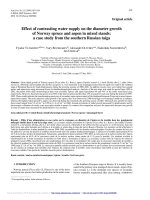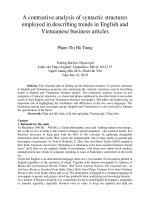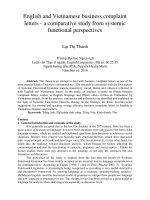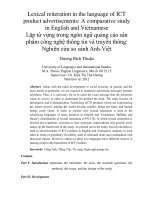English and Vietnamese business complaint letters - a comparative study from systemic functional perspectives
Bạn đang xem bản rút gọn của tài liệu. Xem và tải ngay bản đầy đủ của tài liệu tại đây (144.93 KB, 5 trang )
English and Vietnamese business complaint
letters - a comparative study from systemic
functional perspectives
Lại Thị Thanh
Trường Đại học Ngoại ngữ
Luận văn Thạc sĩ ngành: English Linguistics; Mã số: 60 22 15
Người hướng dẫn: M.A. Nguyễn Huyền Minh
Năm bảo vệ: 2010
Abstract. This thesis is an attempt to deal with business complaint letters as one of the
most popular kinds of business correspondence. The research is concerned with the four aspects
of Systemic Functional Grammar namely transitivity, mood, theme and cohesion reflected in
both English and Vietnamese letters. In the study, an analysis is made on fifteen business
complaint letters written in English language and fifteen others written in Vietnamese by
Vietnamese people. From the analysis, similarities and differences are identified and explained in
the light of Systemic Functional Theories. Basing on the findings, the thesis provides some
suggestions for writing and teaching writing effective business complaint letters in English to
Vietnamese learners and teachers.
Keywords. Tiếng Anh; Ngữ pháp chức năng; Tiếng Việt; Kinh doanh; Thư
Content
1. General introduction and rationale of the study
It is generally accepted that in the last few decades of the 20
th
century, there has been a
great source of research on language; however, their attentions were only paid to the form of the
language systems, which are studied and explained apart from their functions in relation to social
situations. Besides, their concern was basically with structural theories, which show that small
units were arranged and combined into larger ones. The recent research, on the other hand, has
fallen into the tendency toward discourse analysis, which focuses on factors affecting the
communication and also the functioning of syntactic, pragmatic and social aspects. Unlike the
former studies, these ones pay attention to the meaning of not only the sentences but also
utterances and discourses.
The preference of the study is inspired from the fact that the theory of Systemic
Functional Grammar has been widely accepted as an essential tool in language comprehension
for communication. According to Eggins (1994: 1 cited in Thao, Phuong 2003: 2), „Systemic
Functional Linguistics is increasingly being recognized as providing a very useful descriptive
and interpretive framework for viewing language as a strategic, meaning-making resource‟.
Hallidayan linguists used the functional model of grammar to interpret how people use language
and how language is structured for use. This theory, in fact, has been proved as a great model of
language for analysts when analyzing texts especially at discourse level.
In Vietnam, there have been a great number of studies in the area of discourse analysis
these days. However, the number of those works based on Systemic Functional Perspectives
does not seem to reflect the potential variety. Especially in the last few decades, Vietnam has
been seen its expanding relationship with many other nations in economics, scientific and
technical fields; English language as an international language, therefore, has been widely used
in every field, especially in business communication in general and business transaction in
particular. The issues of business communication as well as business transaction thus should be
unsurprisingly a rich source for linguists in analyzing discourse. An inspirational source that
helps me to prompt the choice of the analysis of business correspondence is the fact that this kind
of letter is truly suitable and essential in Vietnamese background recently.
It cannot be denied that business correspondence plays an important role in business
communication. Besides, it is a fact that defects seem to be unavoidable in carrying out business
transactions; even for the best-managed organizations this seems to be in the same case. Letters
of complaint, therefore, can be made and understood as customers‟ inevitable reaction. In
Vietnam, customers have gradually had the tendency to write complaint letters; however, this has
not become their habit and a number of customers, in fact, still hesitate to do this although they
know they have the right to do. In addition, knowing how to write an effective business
complaint letter is really a challenge for many people. My own observation shows that even the
students of business have limited knowledge and experience in writing complaint letters not only
in English but also in Vietnamese.
In the hope of working out some solutions to help Vietnamese people as well as
Vietnamese students, to some extent, overcome their difficulties in writing business complaint
letters, the study is an attempt to analyze some basic discourse features of business complaint
letters from Systemic Functional Perspectives. Based on this, similarities and differences
between English letters and Vietnamese ones will be identified. After that, some suggestions will
be drawn out to improve the studying and teaching writing business complaint letters in English.
2. Aims of the study
The object of the study focuses on only one kind of business letters, namely, the letters of
business complaint in both English and Vietnamese. Due to the constraints in time and limited
knowledge in Business English, this thesis will not deal with all aspects of complaint letters but
concentrate on analyzing transitivity pattern, mood, thematic pattern, and cohesion of letters in
the light of Systemic Functional Grammar. The study aims at:
- Presenting and describing transitivity pattern, mood pattern, thematic pattern and
cohesion in both English and Vietnamese business complaint letters;
- Identifying the similarities and differences in both English and Vietnamese business
complaint letters in terms of transitivity pattern, mood pattern, thematic pattern and
cohesion;
3. Scope of the study
Business letters are the primary and useful tools of exchanging ideas, facts,
recommendations, proposals and so on within a business or between a business and other
businesses and individuals, which give chances to businesses to operate efficiently and
productively. Effective letter writing involves the use of grammar and vocabulary, discourse
cohesive devices and the communicative strategies. As mentioned above, due to the constrain in
time and knowledge and the limitation of a minor thesis, the research cannot explore all the
aspects of this broad area but only the transitivity pattern, mood pattern, thematic pattern and
cohesion of the letters.
The investigation and analyses have been based on the data in 30 business complaint
letters written by both English and Vietnamese native speakers (15 in English and 15 in
Vietnamese; both types of letters are numbered from 1 to 15 for more convenient reference)
which I presume to be sufficient data. These data are collected from textbooks, internet, and
authentic English and Vietnamese business complaint letters written by businesses and
customers as well as other business associates.
4. Method of the study
The study is confined to the description, analysis and comparison in terms of transitivity,
mood, thematic pattern and cohesion. In order to achieve the goal, the approach is inductive,
which is based on the data as well as authentic business complaint letters.
Firstly, a large number of business complaint letters will be carefully selected from
textbooks, internet and authentic sources. Because of the fact that there seems to be no
fixed format for this kind of correspondence, the letters were randomly chosen as data,
providing they are of business complaints. In addition, the authenticity is highly
appreciated by the authors; most of the letters are, therefore, mainly chosen from
authentic sources as mentioned above.
Secondly, a certain number of the selected letters will be described and analyzed in terms
of transitivity, mood, thematic pattern and cohesion.
Thirdly, the data obtained will be analyzed and compared in order to find out the
similarities and differences in both English and Vietnamese business complaints.
Finally, the research results will be discussed to figure out some suggested ideas to help
Vietnamese people write effective business complaints in English.
Besides, discourse analysis in the light of Systemic Functional Grammar helps to
establish the framework of the theoretical background.
5. Design of the study
This study is comprised of three parts:
Part One of this study is an introduction presenting some background information and the
rationale of the study. The aims, the scope and method of the study are also dealt with in this
chapter.
Part Two consist of three chapters.
Chapter One is aimed to present the theoretical background of the work. Some essential
concepts closely related to the study are carefully discussed one by one. Firstly, some theories of
discourse including the concept of discourse, functions of language, and discourse context. Next,
in terms of Systemic Functional Grammar, some concepts such as transitivity, mood, theme-
rheme, and cohesion consisting of reference, substitution, ellipsis, lexical cohesion, and
conjunctive cohesion are presented. Finally, the definition, purpose, three contextual parameters
and structure of business complaint letters are also discussed in the chapter.
Chapter Two attempts to analyze business complaint letters in both English and
Vietnamese in the light of Systemic Functional Grammar. In this chapter, the four chosen terms
of transitivity, mood, theme-rheme and cohesion which consists of reference, substitution,
ellipsis, lexical cohesion and conjunctive cohesion are carefully analyzed to help figure out the
differences and similarities of business complaint letters in the two languages in the next chapter.
Chapter Three is concerned with the discussion of the similarities and differences between
English and Vietnamese business complaint letters in terms of transitivity, mood, theme-rheme
and cohesion.
The last part is set up to summarize the whole research. Some useful implications for
studying and teaching writing effective business complaint letters are also drawn out in this
chapter.
References
English source
1. Bertha J.Naterop, Erich Weis & Eva Haberfellner, (1977), Business letters for all, OUP.
2. Bloor, T. & M. Bloor, (1995), The Functional analysis of English, Arnold.
3. Cook, G. (1989), Discourse, Oxford: Oxford University Press.
4. Eggins, S., (1994), An Introduction to Systemic Functional Linguistics, London/New York:
Continuum.
5. G. Brown and G. Yule, (1983), Discourse analysis, Cambridge: Cambridge University Press.
6. Giang, Hoàng Thu, (2003), An Analysis of English and Vietnamese Claim Letters in terms of
Speech acts and Politeness strategies, Unpublished M.A. Dissertation, College of Foreign
Languages, VNU- Hanoi.
7. Hải, Trần Thị Thanh, (2001), A Contrastive Analysis of English and Vietnamese Sales
Letters, Unpublished M.A. Dissertation, College of Foreign Languages, VNU- Hanoi.
8. Halliday, M.A.K & R. Hasan, (1989), Language, Context, and Text: Aspects of language in
a Social-Semiotic Perspective, Victoria: Deakin University Press.
9. Halliday, M.A.K, & J.K. Martin, (1993), Writing Science: Literary and Discursive Power,
London: Falmer.
10. Halliday, M.A.K, (1994), An Introduction to Functional Grammar, London: Edward Arnold.
11. Halliday, M.A.K, (2004), The Language of Science, Continuum Intl Pub Group.
12. Halliday, M.A.K. and Hasan, K.R., (1976), Cohesion in English, London: Longman Group
Ltd.
13. Halliday, M.A.K., (1985), An Introduction to Functional Grammar, London: Arnold.
14. Hatim and Mason (1990), Discourse and the translator, Longman (London and New York)
15. Lộc, Dương Văn , (2001), Research Paper as a Genre in English and Vietnamese: A
Systemic Functional Comparison, Unpublished M.A. Dissertation, College of Foreign
Languages, VNU- Hanoi.
16. Mai, Đặng Phương, (2007), English and Vietnamese Job Application Letters in terms of
Discourse Cohesive Devices – A Contrastive Analysis, Unpublished M.A. Dissertation,
College of Foreign Languages, VNU- Hanoi.
17. Nunan, D. (1993). Introducing discourse analysis . London: Penguin.
18. Phương Thảo, (2003), Abstracts of Scientific Papers in English and in Vietnamese: A
Systemic Functional Comparison, Unpublished M.A. Dissertation, College of Foreign
Languages, VNU- Hanoi.
19. Thompson, G., (1996), Introducing Functional Grammar, New York: OUP.
20. Vân, Hoàng Văn , (2006), Introducing Discourse Analysis, NXBGD.
Vietnamese source
1. Ban, Diệp Quang, (chủ biên), (2000), Ngữ pháp Tiếng Việt, NXBGD.
2. Hạo, Cao Xuân , (1991), Sơ thảo Ngữ pháp Chức Năng, Quyển 1, Hà Nội: KHXH.
3. Hạo, Cao Xuân, (chủ biên), (1999), Ngữ pháp Chức Năng Tiếng Việt, Quyển 1: Câu trong
Tiếng Việt, NXBGD.
4. Triết, Lê Minh & Thanh, Lê Ngọc, (2004), Hướng dẫn viết thư Tiếng Anh trong Khoa học
và Kinh doanh, NXB Cà Mau.
5. Vân, Hoàng Văn , (1998), “Những ứng dụng cơ bản của Ngôn ngữ Chức năng Hệ thống”,
Tạp chí Khoa học ĐHQG Hà Nội, KHXH, Tập XIV, Số (5), trang 22-24
6. Vân, Hoàng Văn , (2002), Ngữ pháp kinh nghiệm của cú Tiếng Việt mô tả theo quan điểm
Chức năng Hệ thống, Hanoi: KHXH.
Internet sources
1. />%E1%BA%BFun%E1%BA%A1it%E1%BB%91c%C3%A1o&article=532 [accessed on
28/02/10]
2. [accessed on 28/02/10]
3. [accessed on 28/02/10]
4. [accessed on 28/02/10]
5. t-
dongnai.gov.vn/CSDLKHCN/Hosogiaiquyetkhieunai/tabid/103/language/vi-
VN/Default.aspx [accessed on 28/02/10]
6. [accessed on 28/02/10]
7. [accessed on 28/02/10]
8. [accessed on 28/02/10]
9. [accessed on 28/02/10]
10. [accessed on 28/02/10]
11. [accessed on 28/02/10]
12. [accessed on 28/02/10]
13. [accessed on 28/02/10]
14. [accessed on 28/02/10]
15. [accessed on 28/02/10]
16. [accessed on 28/02/10]









